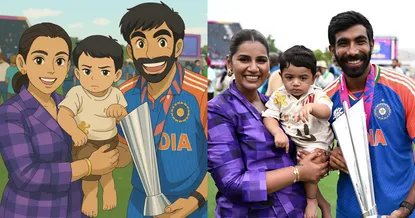Transforming a Regular Photo into a Cartoon Image In the digital age, turning a regular photo into a cartoon has grown in popularity as a way to give pictures a unique and artistic feel. This technique, called “cartoonization,” is adding several creative effects to photographs to create pictures that look like cartoons or illustrations. Cartoonizing images provides a distinctive and captivating visual experience, whether for personal use, marketing collateral, or social network accounts.
Photo Editing: The Art, Science, and Technology Behind Image Enhancement
Photo editing has become an essential part of our digital lives, influencing everything from personal social media profiles to high-end advertisements and cinematic productions. In the modern world, almost every image seen is touched up, altered, or enhanced in some form. Photo editing is not merely about adjusting colors or removing blemishes; it is an intricate blend of art, technology, and psychology. This essay delves deeply into the history, techniques, tools, and ethical considerations of photo editing, revealing how it has shaped visual culture and how it continues to evolve in the digital age.
I. A Brief History of Photo Editing
Photo editing has a long history that begins with the invention of photography. Photographers started experimenting with image manipulation as early as the 19th century, but digital manipulation wasn’t possible until the late 20th century. Techniques like hand-coloring photos or merging images using double exposures were popular in the early days. One of the first important steps toward modern photo editing was the development of the darkroom. Photographers may adjust the exposure, contrast, and light balance of their images in these darkrooms. For portrait photographers and those looking to add dramatic effects, this gave them more control over the finished product.
The introduction of digital photography in the 1990s brought about the real revolution in photo editing. Digital image alteration became much more advanced in 1987 with the release of programs like Adobe Photoshop. With its pixel-level tweaks, layer-based editing, and more sophisticated features like content-aware fills, blurring effects, and the ability to smoothly composite several photos, Photoshop rose to prominence as the industry standard for photo editing.
II. Techniques in Photo Editing
The field of photo editing is vast and includes many different methods. These methods fall into a number of areas, ranging from sophisticated visual effects and image compositing to color correction and retouching.
A. Color Correction and Enhancement
Normal Photo Into Cartoon Photo Color correction is one of the most fundamental techniques in photo editing. It ensures that the colors in the image appear accurate or are adjusted to evoke a specific mood or effect. This includes adjusting the white balance, saturation, contrast, brightness, and hue to ensure the image looks its best.
For example, in portrait photography, color correction is often used to adjust skin tones and balance out harsh lighting. If the image was shot under fluorescent lighting, it might have a greenish tint, which can be corrected by adjusting the color balance to achieve a natural appearance. Furthermore, enhancing colors can make an image appear more vibrant and dynamic, such as boosting the saturation of a sunset or a cityscape to make the colors more vivid and eye-catching.
For instance, color correction is frequently used in portrait photography to balance out harsh lighting and modify skin tones. The photograph may have a greenish tint if it was taken in fluorescent lighting; this can be fixed by altering the color balance to make it look more natural. Additionally, strengthening colors can give the impression that an image is more dynamic and colorful. For example, increasing the saturation of a cityscape or sunset can make the colors more striking and vivid.

B. Retouching
Retouching is the process of enhancing an image’s overall quality by eliminating flaws and adjusting details. For instance, retouching frequently entails removing wrinkles, blemishes, and other flaws that diminish the subject’s attractiveness in portrait photography. It also covers methods like tooth whitening and eye brightening. To increase focus and clarity, retouching tools in programs like Photoshop can selectively blur or sharpen specific areas of an image.
Although retouching is frequently linked to ideals of beauty, it is also utilized in fashion and commercial photography to guarantee that apparel, products, and other items look perfect. Product photography is another area where retouching can be used to make an object appear as detailed and appealing as possible for marketing purposes.
C. Compositing and Layering
One of the more sophisticated picture editing methods is compositing, which combines several images into a single, coherent image. This method is frequently employed in artistic photography, cinema, and advertising. In order to make the additional pieces fit in perfectly with the background, a photographer can, for instance, take a landscape shot and then add a person, animal, or item to the frame.
Normal Photo Into Cartoon Photo Layering allows photo editors to work on different elements of an image without affecting the entire picture. Each layer can be edited individually, making it easier to tweak specific aspects of the image without ruining the original photo. This flexibility is crucial when working on complex compositions or retouching large numbers of images.
D. Special Effects and Filters
Special effects and filters have become increasingly popular in modern photo editing. From Instagram-style filters that create a vintage or nostalgic look to dramatic effects such as adding fire, smoke, or surreal elements to an image, these tools can radically change the mood and atmosphere of an image. These effects are often used to tell a specific story or to make an image stand out in an artistic or commercial setting.
Filters are pre-programmed adjustments that alter the color balance, contrast, and saturation of an image, giving it a specific look or feel. Special effects, on the other hand, may involve more complex manipulations, such as the application of textures, creating 3D elements, or simulating weather effects like rain or fog. Both tools can be used to convey emotion, enhance visual storytelling, or create entirely new visual experiences.
III. Tools and Software for Photo Editing
Over the years, photo editing software has evolved from basic programs to highly sophisticated applications. These tools empower photographers, graphic designers, and artists to bring their visions to life with ease.

A. Adobe Photoshop
Converting a Regular Photo into a Cartoon Image The world’s most popular photo editing program is Adobe Photoshop. It has established itself as the industry standard for experts in a wide range of fields thanks to its robust features. Photoshop provides a variety of capabilities, ranging from simple tweaks to more complex methods like 3D modeling, animation, and VR integration. With its range of brushes, filters, and adjustment layers, Photoshop’s layer-based editing system guarantees total creative flexibility while enabling users to work on each component of a picture separately.
B. Lightroom
Adobe Lightroom is designed primarily for photographers who need to edit and improve huge batches of photos, whereas Photoshop is frequently thought of as the preferred tool for intricate photo manipulation. For operations like batch processing, exposure tweaks, and color grading, Lightroom is perfect. Because it offers non-destructive edits—meaning the original image is never permanently changed—it enables photographers to optimize their workflows.
C. GIMP (GNU Image Manipulation Program)
An open-source, free substitute for Photoshop is GIMP. It might not have as many features or be as well-designed, but it offers a good collection of editing tools for both simple and complex photo editing. Due to its affordability, GIMP is especially well-liked by small enterprises and hobbyists.
D. Mobile Apps
With the rise of smartphone photography, mobile apps have made photo editing more accessible than ever. Apps like Snapseed, VSCO, and Prisma allow users to apply filters, adjust settings like exposure and contrast, and even perform some advanced edits like object removal and skin smoothing, all on the go. These tools have made photo editing highly accessible, democratizing the ability to enhance images for everyone from casual social media users to professional photographers.
IV. The Ethical Implications of Photo Editing
While photo editing has brought about a new level of creativity and control over images, it has also raised serious ethical concerns. The ability to manipulate images so seamlessly has profound implications, especially when it comes to the representation of beauty, identity, and truth.
A. The Impact on Beauty Standards
The impact of photo manipulation on beauty standards is among the most well-known ethical concerns surrounding it. Models’ photographs are regularly altered in the fashion and beauty sectors to give them the “ideal” look. This frequently entails minimizing bodily components, getting rid of imperfections, and even changing facial characteristics. As a result, viewers may experience low self-esteem or feelings of inadequacy due to the inaccurate representation of beauty.
Since altered photos might deceive viewers about a person’s “real” appearance, the emergence of social media influencers and celebrities has also raised awareness of this problem. Many people, particularly young women and girls, experience pressure to live up to these standards, which exacerbates problems with body image.
B. Misleading Information
Misinformation also often relies on photo alteration. It is simple to distort photos to further particular political or social objectives because of the high degree of image alteration capabilities. For example, manipulated photos of celebrities or politicians are frequently shared on social media to support a certain narrative or propagate misleading information. The public may find it challenging to distinguish between what is real and what is fake as a result of the distortion of reality caused by these visuals.

C. The “Fake Perfection” Problem
In a world increasingly filled with “Instagram-perfect” images, the pressure to create a flawless persona has never been higher. While photo editing can enhance a person’s appearance, it can also lead to a false representation of reality. This obsession with perfection can have adverse effects, leading to unrealistic expectations in both personal and professional realms.
V. The Future of Photo Editing
Artificial intelligence (AI), machine learning, and more sophisticated software development are the keys to the future of photo editing. Aspects of photo editing like content-aware fill, sky replacement, and facial identification are already starting to be automated by AI systems. Photo editing will probably become much more natural and user-friendly as AI advances, enabling even more complex manipulation with less work.
Additionally, by enabling users to engage with photographs in three dimensions, virtual reality (VR) and augmented reality (AR) are creating new opportunities for photo editing. With the ability to “step inside” their photographs and make adjustments from various perspectives, these new tools have the potential to transform the way editors and photographers approach their work.
Image Enhancement
Photo editing has become an essential part of our digital lives, influencing everything from personal social media profiles to high-end advertisements and cinematic productions. In the modern world, almost every image seen is touched up, altered, or enhanced in some form. Photo editing is not merely about adjusting colors or removing blemishes; it is an intricate blend of art, technology, and psychology. This essay delves deeply into the history, techniques, tools, and ethical considerations of photo editing, revealing how it has shaped visual culture and how it continues to evolve in the digital age.
I. A Brief History of Photo Editing
The history of photo editing dates back to the very birth of photography itself. While digital manipulation only became feasible in the late 20th century, even in the 19th century, photographers were experimenting with image alterations. In the early days, techniques like hand-coloring photographs or combining images through double exposures were common. The invention of the darkroom was one of the first significant steps toward photo editing as we know it today. In these darkrooms, photographers could manipulate the exposure, contrast, and light balance of their prints. This allowed for more control over the final image, which was vital for portrait photographers and those seeking to create dramatic effects.
The introduction of digital photography in the 1990s brought about the real revolution in photo editing. Digital image alteration became much more advanced in 1987 with the release of programs like Adobe Photoshop. With its pixel-level tweaks, layer-based editing, and more sophisticated features like content-aware fills, blurring effects, and the ability to smoothly composite several photos, Photoshop rose to prominence as the industry standard for photo editing.
II. Techniques in Photo Editing
The field of photo editing is vast and includes many different methods. These methods fall into a number of areas, ranging from sophisticated visual effects and image compositing to color correction and retouching.
A. Color Correction and Enhancement
One of the most basic methods in photo editing is color correction. It guarantees that the image’s colors seem true to life or are modified to produce a particular impact or mood. To make sure the picture looks its best, this entails modifying the white balance, saturation, contrast, brightness, and hue.
For instance, color correction is frequently used in portrait photography to balance out harsh lighting and modify skin tones. The photograph may have a greenish tint if it was taken in fluorescent lighting; this can be fixed by altering the color balance to make it look more natural. Additionally, strengthening colors can give the impression that an image is more dynamic and colorful. For example, increasing the saturation of a cityscape or sunset can make the colors more striking and vivid.
B. Retouching
Normal Photo Into Cartoon Photo Retouching refers to the process of improving the overall quality of an image by removing imperfections and fine-tuning details. In portrait photography, for example, retouching often involves the removal of blemishes, wrinkles, and other imperfections that detract from the subject’s appearance. It also includes techniques like whitening teeth or brightening the eyes. Retouching tools in software like Photoshop can selectively blur or sharpen different parts of an image to improve focus and clarity.
Although retouching is frequently linked to ideals of beauty, it is also utilized in fashion and commercial photography to guarantee that apparel, products, and other items look perfect. Product photography is another area where retouching can be used to make an object appear as detailed and appealing as possible for marketing purposes.

C. Compositing and Layering
One of the more sophisticated picture editing methods is compositing, which combines several images into a single, coherent image. This method is frequently employed in artistic photography, cinema, and advertising. In order to make the additional pieces fit in perfectly with the background, a photographer can, for instance, take a landscape shot and then add a person, animal, or item to the frame.
Photo editors can alter individual components of an image without altering the final product because to layering. Because each layer may be altered separately, it’s simpler to make changes to particular areas of the picture without destroying the original. When working on intricate compositions or retouching a lot of photos, this adaptability is essential.
D. Special Effects and Filters
Normal Photo Into Cartoon Photo Special effects and filters have become increasingly popular in modern photo editing. From Instagram-style filters that create a vintage or nostalgic look to dramatic effects such as adding fire, smoke, or surreal elements to an image, these tools can radically change the mood and atmosphere of an image. These effects are often used to tell a specific story or to make an image stand out in an artistic or commercial setting.
Filters are pre-programmed changes that give an image a certain look or feel by changing its saturation, contrast, and color balance. However, more intricate manipulations, such applying textures, producing 3D objects, or mimicking weather effects like fog or rain, may be a part of special effects. Emotional expression, improved visual storytelling, and the creation of completely original visual experiences are all possible with both tools.
III. Tools and Software for Photo Editing
From simple programs to quite complex applications, photo editing software has changed over time. Photographers, graphic designers, and painters can easily realize their ideas with the help of these tools.
A. Adobe Photoshop
Normal Photo Into Cartoon Photo Adobe Photoshop is the most widely used photo editing software in the world. With its powerful features, it has become the industry standard for professionals across many fields. Photoshop offers a range of tools, from basic adjustments to advanced techniques such as 3D modeling, animation, and virtual reality (VR) integration. Photoshop’s layer-based editing system allows users to manipulate each element of an image independently, while its suite of brushes, filters, and adjustment layers ensures complete creative freedom.
B. Lightroom
Normal Photo Into Cartoon Photo While Photoshop is often seen as the go-to tool for complex photo manipulation, Adobe Lightroom is tailored more toward photographers who need to adjust and enhance large batches of images. Lightroom is ideal for tasks like color grading, exposure adjustments, and batch processing. It allows photographers to streamline their workflows by offering non-destructive edits, meaning the original image is never altered permanently.
C. GIMP (GNU Image Manipulation Program)
An open-source, free substitute for Photoshop is GIMP. It might not have as many features or be as well-designed, but it offers a good collection of editing tools for both simple and complex photo editing. Due to its affordability, GIMP is especially well-liked by small enterprises and hobbyists.
D. Mobile Apps
Photo editing is now easier than ever thanks to mobile apps and the growth of smartphone photography. Users may add filters, change exposure and contrast, and even carry out more complex edits like object removal and skin smoothing while on the fly with apps like Snapseed, VSCO, and Prisma. From amateur social media users to professional photographers, these technologies have democratized the capacity to improve photographs through photo editing.

IV. The Moral Consequences of Photo Editing
A new degree of creativity and control over photographs has been made possible by photo editing, but there are also significant ethical issues with it. The seamless manipulation of photographs has significant ramifications, particularly in relation to the portrayal of truth, identity, and beauty.
A. The Impact on Beauty Standards
Transforming a Regular Photo into a Cartoon Image The impact of photo manipulation on beauty standards is among the most well-known ethical concerns surrounding it. Models’ photographs are regularly altered in the fashion and beauty sectors to give them the “ideal” look. This frequently entails minimizing bodily components, getting rid of imperfections, and even changing facial characteristics. As a result, viewers may experience low self-esteem or feelings of inadequacy due to the inaccurate representation of beauty.
Since altered photos might deceive viewers about a person’s “real” appearance, the emergence of social media influencers and celebrities has also raised awareness of this problem. Many people, particularly young women and girls, experience pressure to live up to these standards, which exacerbates problems with body image.
B. Misleading Information
Photo editing also plays a critical role in misinformation. With the ability to alter images to such a high degree, it is easy to manipulate photos to serve specific political or social agendas. For instance, altered images of politicians or celebrities are often circulated on social media to spread false narratives or enhance a particular narrative. These images can be used to distort reality, making it difficult for the public to discern what is real and what is fake.
C. The Issue of “Fake Perfection”
The demand to project a faultless character has never been greater in a world where “Instagram-perfect” photos are becoming more and more common. A person’s appearance can be improved through photo editing, but it can also result in an inaccurate portrayal of reality. Unrealistic expectations in both the personal and professional spheres might result from this fixation with perfection.
V. Photo Editing’s Future
Artificial intelligence (AI), machine learning, and more sophisticated software development are the keys to the future of photo editing. Aspects of photo editing like content-aware fill, sky replacement, and facial identification are already starting to be automated by AI systems. Photo editing will probably become much more natural and user-friendly as AI advances, enabling even more complex manipulation with less work.
Additionally, by enabling users to engage with photographs in three dimensions, virtual reality (VR) and augmented reality (AR) are creating new opportunities for photo editing. With the ability to “step inside” their photographs and make adjustments from various perspectives, these new tools have the potential to transform the way editors and photographers approach their work.
Conclusion
The way we produce, distribute, and view photos has been completely transformed by the potent instrument of photo editing. It shapes our visual environment by fusing technical mastery, artistic expression, and psychological understanding. Our ideas of realism, authenticity, and beauty will continue to be challenged by photo alteration as digital tools and techniques advance. It has enormous creative possibilities, but it also brings up significant moral dilemmas regarding truth, representation, and the social influence of pictures. Ultimately, photo editing is about influencing our perception of the world, one pixel at a time, rather than merely changing an image.

